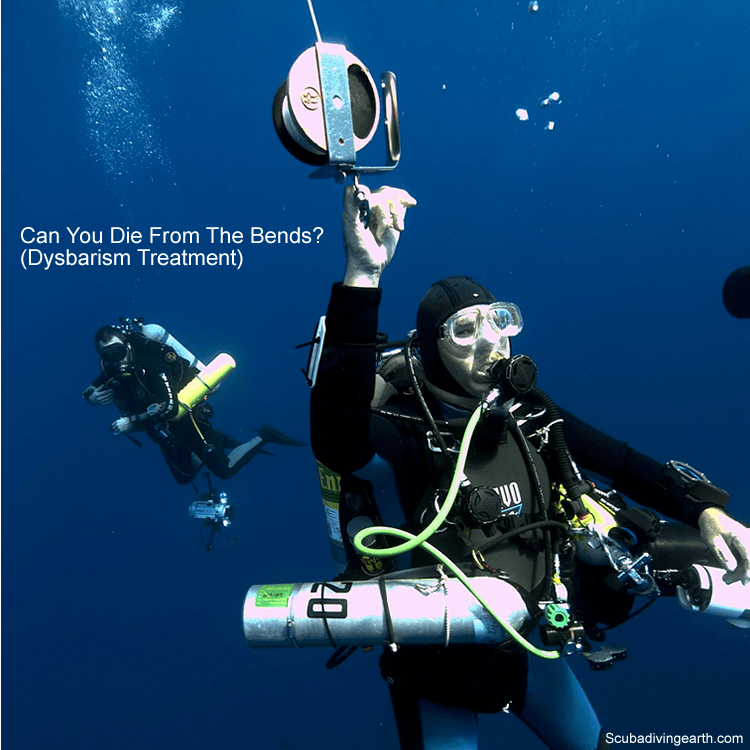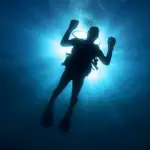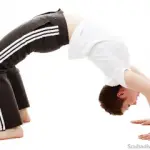
Can the bends kill you when you’re scuba diving? Please read on to find out
When I wrote my more recent article on “what is it called when a diver comes up too fast,” I saw that people also ask “can you die from the bends” too.
You can die from the bends and decompression sickness can kill you in extreme cases. An example of this is explained in a story in National Geographic of a scuba diver dying from the bends when he was diving to a depth of 122 metres (400 feet) whilst filming the wreck HMHS Britannic in Greece.
The best way to do more diving, without getting the bends of course, is to book yourself on a scuba diving liveaboard. You can check the latest and best deals on liveaboards using the following window:
What is ‘the bends‘ in scuba diving
The bends, which is also known as decompression sickness (DCS) or Caisson disease occurs in scuba divers. It can also occur in high altitude or aerospace events too.
The bends occurs when dissolved gases come out of solution in the form of bubbles. This happens on fast ascents from depth or if a diver misses a decompression stop. These gases, which is mostly nitrogen, were dissolved into a diver’s tissues whilst scuba diving at depth.
The deeper you dive the greater the risk of the bends
The deeper you dive the greater the water pressure. The higher the pressure the more nitrogen gas will be dissolved into the tissues. This is referred to as ‘On-gassing.’
The deeper the dive the greater the risk of the bends on the ascent. The deeper you go the bigger the greater the uptake of nitrogen. But also a deeper dive involves greater pressure changes too.
The bends occurs on ascent as the water pressure decreases. During the ascent as the water pressure reduces, these gases (i.e. nitrogen) slowly leave the tissues (also known as ‘Off-gassing‘) .
But if this ascent is too fast the nitrogen no longer leaves safely and slowly. Instead small nitrogen bubbles are formed. It’s these tiny bubbles that can lead to the bends. The bends that can have dire consequences for you…see below.

But this only becomes a problem if the ascent is faster than it should be, or where any required decompression stops are missed.
In other words, if you dive using safe diving practices you are unlikely to ever suffer from the bends. Having said that there are a number of decompression sickness risk factors you should be aware of before you embark on scuba diving.
The bends can affect almost any part of the body, this includes:
- Minor skin bends.
- Joints pain.
- Lungs.
- Heart.
- Brain
- The spinal cord.
Depending on the severity of decompression sickness, which part of the body is affected and the speed of treatment, will all impact on the casualty’s final fate.

Can you die from the bends?
The bends or decompression sickness, which is also referred to medically as Dysbarism. Dysbarism includes a multitude of symptoms that accompany exposure to excessively rapid changes to environmental pressures.
Dysbarism refers to a medical condition, which results from changes in ambient pressure. There are various activities that are associated with pressure changes, but underwater diving is the most frequently cited example.
But decompression sickness isn’t the only type of Dysbarism, it also includes arterial gas embolisms (AGE), and barotraumas. This can be as minor as a facial barotrauma, which can be caused as a result of mask squeeze.
As a trained scuba diver and having dived for over 30 years, I know that decompression sickness or the bends can have serious consequences. The most serious of all consequences of the bends is death.
Fortunately I’ve not experienced decompression sickness myself, but I’ve been deep diving, i.e. 50+ metres (164 feet+) when my colleagues have experienced a skin bend.
An example of a scuba diver dying from the bends
Interestingly, when I typed this question into Google, up pops an article in the Telegraph Newspaper from back in 2009.
This article is about Carl Spencer who died as a consequence of decompression sickness.
“A Super Puma rescue helicopter was dispatched to collect the diver who was unconscious with decompression sickness symptoms, he did not regain consciousness and was pronounced dead on arrival at the Athens Navy hospital.”
The Telegraph Newspaper – National Geographic diver dies from ‘the bends’ while filming in Greece
Carl Spencer was a National Geographic diver. He died as a consequence of the bends or decompression sickness in Greece, whilst filming as part of a 17-member crew. They were filming the wreck of a British World War I hospital ship HMHS Britannic.
The sister ship of the Titanic, HMHS Britannic sank off the Greek Aegean island of Kea in 1916. This World War I ship sank after hitting a mine, with the loss of 30 lives. Sadly Spencer’s scuba diving death added to the death-toll of this sunken shipwreck.
The HMHS Britannic wreck is considered a deep dive
A dive is considered a deep dive when it’s in excess of around 18-20 metres (60-66 feet).
The HMHS Britannic sits at around 122 metres (400 feet). 122 metres would be considered a seriously deep dive for most scuba divers.
For any scuba diver to dive this deep they not only need to be very experienced, but also they need to be a technical diver too.
Dysbarism treatment or the treatment for the bends
If you or one of your colleagues are unfortunate enough to be affected by the bends you must seek medical treatment urgently.
Dysbarism treatment or what is required treatment for the bends, prior to hospital care includes the following:
- Get the diver out of the water as soon as possible.
- Next immobilise the patient where trauma is suspected.
- Consider ‘in-water recompression‘ but this is not believed to be a safe option.
- Extract the casualty to hospital or hyperbaric chamber ideally by helicopter (this happened in the above case in Greece).
- Give the casualty immediate 100% oxygen and intubate if necessary.
- Intravenously administer a saline drip (treatment unlikely if you’re not medically trained or on a dive boat, but worth mentioning).
More Reading: What should you not do after scuba diving (11 must NOT do’s after diving)
I hope you enjoyed this article about can you die from the bends
I’d love to hear from you. Tell us about your adventures of diving and snorkeling, in the comments below. Please also share your photos. Either from your underwater cameras or videos from your waterproof Gopro’s!
If this article hasn’t answered all of your questions. If you have more questions either about snorkeling or types of scuba diving (or specifically about can you die from the bends), please comment below with your questions.
There will also be many more articles about scuba diving (and snorkeling) for you to read and learn about these fabulous sports.
Have fun and be safe!





